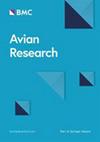头部高度和头宽的乘积是鸟类脑质量的一个强有力的预测指标
IF 1.7
2区 生物学
Q1 ORNITHOLOGY
引用次数: 0
摘要
动物行为学研究经常与认知能力研究相结合。更大的大脑通常意味着更复杂的神经网络和更高级的认知功能。通过测量不同个体动物的大脑大小,我们可以探索不同种群或物种之间行为复杂性的差异。然而,无论是在野外还是在实验室环境中,获得准确的脑尺寸测量都是一项挑战,尤其是对稀有和濒危物种而言。因此,迫切需要开发可靠的方法来执行颅脑肿块。这项研究测试了鸟类头部的哪些外部结构可以最准确地预测大脑的大小。选取了4目5种鸟类,将外部头部测量分为3种参数(直接测量、计算测量和复合测量),并分析了它们与脑质量的关系。结果表明,虽然头部大小可以部分解释脑质量,但头高×头宽是预测鸟类脑质量最准确的参数(90.4%)。此外,脑内体积与脑质量的正相关再次证实了鸟类脑内体积在一定程度上可以作为脑质量的有效代表。我们的研究表明,在未来,我们可以更方便地进行非侵入性测量,以更好地了解鸟类大脑大小与行为、生态和进化之间的关系。本文章由计算机程序翻译,如有差异,请以英文原文为准。
The product of head height and head width is a strong predictor of brain mass in birds
Animal behavioral studies are often combined with research concerning cognitive abilities. Larger brains usually mean more complex neural networks and advanced cognitive functions. By measuring the brain size of different individual animals, we can explore differences in behavioral complexity between populations or species. However, obtaining accurate measurements of brain size is challenging both in field and laboratory environments, especially for rare and endangered species. Therefore, there is an urgent need to develop reliable methods for performing cranial brain mass. This study tests which external structures of the avian head can most accurately predict brain size. We selected five bird species from four orders, categorized external head measures into three types of parameters (direct, calculated and composite measurements), and analyzed these in relation to brain mass. The results showed that while head size can partially explain brain mass, the parameters of head height × head width were the most accurate predictors of brain mass in birds (90.4%). In addition, the positive correlation between endocranial volume and brain mass once again confirmed that avian endocranial volume can, to a certain extent, serve as a valid proxy for brain mass. Our study demonstrates that in the future we can more conveniently perform non-invasive measurements to better understand the relationship between bird brain size and behavior, ecology, and evolution.
求助全文
通过发布文献求助,成功后即可免费获取论文全文。
去求助
来源期刊

Avian Research
ORNITHOLOGY-
CiteScore
2.90
自引率
16.70%
发文量
456
审稿时长
46 days
期刊介绍:
Avian Research is an open access, peer-reviewed journal publishing high quality research and review articles on all aspects of ornithology from all over the world. It aims to report the latest and most significant progress in ornithology and to encourage exchange of ideas among international ornithologists. As an open access journal, Avian Research provides a unique opportunity to publish high quality contents that will be internationally accessible to any reader at no cost.
 求助内容:
求助内容: 应助结果提醒方式:
应助结果提醒方式:


